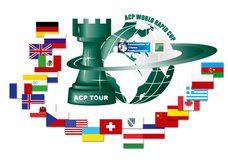First, the overall standings at the top going into the final round:
With 7 points: GM Xiangzhi Bu (China), GM Sandipan , GM Kamil Miton (Poland), and GM Vadim Milov (Switzerland) With 6.5 points: GM's Nigel Short and David Howell (England), GM Mark Bluvshtein and IM Tomas Krnan (Canada), GM Frank De La Paz Perdomo (Cuba), GM Hoang Thong Tu (Vietnam), GM Tomas Likavsky (Slovakia), GM Bator Sambuev (Russia), FM Anton Kovalyov (Argentina, recently moved to Montreal), GM Valery Aveskulov (Ukraine), and IM Leonid Gerzhoy (Israel, now living in Toronto).
So four with 7, and 11 with 6.5. Still quite a horse race! The group with 6 points has 21 players.
*******
So, back to my pick for game of the round:
Sandipan - Tiviakov: Queen's Indian, Pomar Gambit
1.d4 Nf6 2.c4 e6 3.Nf3 b6 4.g3 Bb7 5.Bg2 Be7 6.0–0 0–0 7.d5!? exd5 8.Nh4 c6 9.cxd5 Nxd5
The more ambitious recapture. 9...cxd5 has also been played, but leads to more sterile positions.
10.Nf5 Nc7 11.e4 d5 12.Nc3 Bf6
The starting point for some important games. I had mentioned in the analysis room that this variation had been featured in one of the K-K matches, and after the actual Sandipan game was finished, FIDE Master (FM) Gordon Taylor, who was good enough to join me today in the commentary room, mentioned his recollection of a Marjanovic game (playing Black) that had a very similarly unfortunate result.
Well, it turns out that neither of us is getting any younger, but that our memories are still reasonably intact!
First of all, Kasparov - Karpov, Game 6, Moscow 1984/85. White played 13.Bf4 (before exchanging on d5), and after 13...Bc8 14.g4!? Nba6 15.Rc1 Bd7 16.Qd2 Nc5, and here White may have overplayed his hand with 17.e5 and after a few excellent defensive moves by Karpov, Black was very close to winning. The game ended in an exciting draw in 47 moves, but it was generally thought that Kasparov was a bit lucky to escape with a half point. On move 17. Bxc7 Qxc7 18.exd5 a5!? 19.dxc6 Bxc6 20.g5! looks a more interesting continuation.
So much for the K-K snippet, but where does Marjanovic come into this? Well, it turns out that a somewhat younger Gary Kasparov played 13.exd5 cxd5, and only then 14.Bf4 against GM Marjanov at the 1980 Malta Chess Olympiad. That game continued 14...Nba6 15.Re1 Qd7? (look familiar!) 16.Bh3 Kh8 (instead of Tiviakov's 16...Ne6).
After 17.Ne4 Bxb2 18.Ng5 Qc6 19.Ne7 Qf6 20.Nxh7! Qd4 21.Qh5 g6 22.Qh4 Bxa1 23.Nf6+ 1-0.
Gamescore and punctuation from Moscow Marathon, World Chess Championship 1984/85, Jonathan Speelman and Jon Tisdall. The authors also point out that both 15...Bc8 and 15...Nc5!? are improvements for Black. All this leads us to ask a few questions about what actually happened in the 9th round game today...
13.exd5 cxd5 14.Bf4 Nba6 15.Re1

So, not only was I correct in questioning 15...Qd7 here, but this is a key position of a stem Kasparov game from 27 years ago. I find it hard to believe that Tiviakov was unaware of the Marjanovic game, as he is a renowned expert on the Queen's Indian. Could it be that he simply thought 16...Ne6 was a strong and adequate improvement? Or maybe he really did forget this early theory? 15...Bc8 and 15...Nc5 both return the pawn advantage to White, but as the actual game demonstrated, it may simply be too dangerous to try to hold onto all the material.
15...Qd7?! 16.Bh3 Ne6 17.Ne4!
Using the same theme as in the Kasparov-Marjanovic game above, and undoubtedly Sandipan was aware of it. I made the comment as the game was unfolding the White was using an attacking mechanism that I once read Mikhail Tal referred to as "launching" - simply throw a bunch of units at the enemy King and try to build up a substantial numerical superiority. White's pieces are all headed at Black's King, while Black's defenders are either too far away or diverted elsewhere (in this case, one is busy capturing P/b2).
17...Bxb2 18.Rb1 Bc8 19.Ng5 Bf6 20.Qh5!
Five to three: White's forces are massing.
20...Bxg5 21.Bxg5 Re8
Pretty much forced to stop a nasty N/f5-e7+ in many lines.
Fantastic. White throws a bishop into the works simply to gain access to h6 and tie down the N/e6. The threat now is R/b1-d1-d4-g4+ and Qxf6 mate. Remarkably there seems to be very little for Black to do about this despite being up a piece and two pawns!
23...Nac5 24.Rbd1 Qb7
Tiviakov steps off the d-line, hoping to make ...N/c5-e4 work, but that defensive idea proves to have a beautiful refutation.
25.Rd4! Ne4
Everything is working for White. Knowing the Kasparov game undoubtedly gave White some confidence, but it has been Sandipan all the way since 15...Ne6, and the ? on Black's 15th ...Qd7 may be fully warranted. I haven't seen much in the way for improvements for Black along the way.
26...dxe4 27.Qxf6 Qc7
Sad, but there appears to be no way to even prevent checkmate! If 27...Bd7, blocking the d-file and hoping to escape with the King to d8, the bishop interferes with Black's defence of f7 and Black is mated with 28.Nh6+ and 29.Qxf7#. Likewise, the hopeless 27...h5 just loses differently: 28.Nh6+ Kh7 29.Bf5#.
28.Nh6+ Kf8 29.Qh8+ Ke7 30.Nf5# 1–0.
A painful loss for Tiviakov, but I would be curious to know whether he willingly entered this, expecting 16...Ne6 to be an improvement, and miscalculated something, or whether he simply forgot about the old Kasparov game. This gambit line, 7.d5!?, is not played that often, so either possibility is quite plausible.





No comments:
Post a Comment